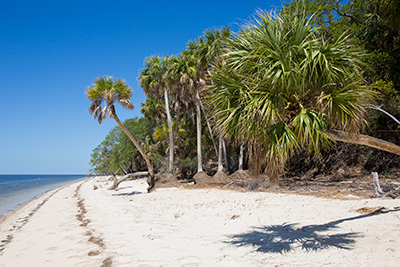Salt-Tolerant Plants
One of Florida’s many charms is that no matter where you are, there’s likely to be a beach nearby. But this combination of salty soil and sea spray does affect which plants will—and won’t—succeed.

If you’re one of the many Floridians who lives within a couple miles of salt water, you’ve probably seen your fair share of salt-spray damage.
Plants installed within about one-eighth of a mile of saltwater coasts should be at least somewhat salt tolerant. Below is our list of salt-tolerant plants. All the species listed have high salt tolerance except where noted, making them excellent options for your coastal landscape.
Groundcovers and Flowers
On the coastline, flowering groundcovers are a good source of color. Beach sunflower, gaillardia, and seaside goldenrod are all wind and salt tolerant enough to brighten up an ocean view. Railroad vine and gopher apple spread quickly, too, and make excellent groundcovers and dune stabilizers. And if you’re looking for more flowers, try annuals like calendula and petunia.
Grasses
Ornamental grasses give coastal landscapes that classic wind-swept look. Saltmeadow cordgrass, muhly grass, Fakahatchee grass, and sea oats are all at least moderately salt tolerant. They’re Florida native species, too!
For turfgrasses that can withstand the salt and wind, see our article on “Salt-Tolerant Lawngrasses.” We would also suggest contacting your county Extension office to ask which varieties perform best in your area.
Vines
There are a few vine options for coastal landscapes. Native railroad vine is a creeping type, with high tolerance for salty air and sandy soils. And, though only moderately salt tolerant, bougainvillea does well in landscapes a little further inland.
Trees and Shrubs
For trees that can handle the salt, live oak, southern red cedar, and mangrove are always safe choices. Southern magnolia is moderately salt tolerant, but shouldn’t be planted on the coastline.

Palms are all at least moderately salt tolerant. The highest tolerance is found in our native cabbage palms and saw palmettos. Washington palms are also very salt tolerant.
For flowering coastal shrubs, hibiscus, firebush, plumeria, and sterile lantana varieties are show-stopping choices. For something truly unique, however, try our native wild coffee, necklace pod, or saltbush. Oleander is beautiful too, but highly toxic. Be cautious when adding this plant to your landscape.
Some coastal communities prefer more xeric landscape elements. Agaves, yucca (especially Spanish bayonet and Adam’s needle), prickly pear, and sea lavender all add to a desert-scape appearance. For more classic choices, try juniper, Indian hawthorn, waxmyrtle, or coontie.
Edible landscapes are popular and there are a number of salt-tolerant edibles that double as ornamental shrubs. Seagrape, cocoplum, and pineapple guava are favorites, certainly. Yaupon holly isn’t edible, but the leaves can be used to make caffeinated yaupon holly tea.
Finally, for a uniquely South Florida feel, mahogany, soapberry, gumbo-limbo, silver buttonwood and crown of thorns are all excellent choices. These plants thrive in USDA Hardiness Zones 10 and 11.
Coastal Landscape Care
Many coastal plants perform significantly better with a little care. Even with salt water abundantly available, coastal plants need fresh water to thrive. Establishing coastal plants carefully is also very important, even on the coast. Fresh water during this establishment period, or during times of stress, can make all the difference to a plant’s long-term success. For more on seaside landscaping see our article on coastal landscapes.
To discover more plants that will thrive in your landscape, contact your county Extension office.
Also on Gardening Solutions
More from UF/IFAS
- Five Salt-tolerant Native Plants for Coastal Florida–UF/IFAS Blogs Indian River County
- Landscape Plants: Sapindus saponaria, Florida Soapberry
- Uniola paniculata Sea Oats
